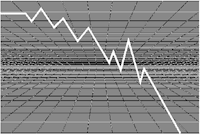 by Michael R. Lee, Ph.D.
by Michael R. Lee, Ph.D.
What we have here is a series of distressing, if unrelated, numbers. One is going up, two are going down.
The first number, and probably the most relevant to readers of this publication, concerns the quantity of production required of Imaging Directors of radio stations.
Though it does not entail rigorous research techniques, conversations with Imaging Directors over the last several months indicate a clear pattern of programmer abuse regarding sweepers and promos.
There seems to be an epidemic of programmers who think that a sweeper is airable three to five times and then must be replaced. Are listeners tired of the sweeper by then? Or have programmers become hyper-sensitive to produced sweepers and promos and insensitive to the realities of creativity and human endurance?
As sweepers and promos become more important to the sound of the station, in some cases even defining the sound of the radio station, it is not unrealistic to think that programmers will pay more attention to them. Surely, we are not in a laissez faire era when it comes to on-air imaging. Nor should we be.
But listener burnout and programmer fatigue are clearly unrelated. After all, listener burnout to music titles is tested locally and nationally and reported widely in trade magazines. No such data are available for sweepers and promos. There is only the “gut feeling” of Program Directors to go by. As numbers later in this article clearly indicate, listeners are not listening nearly as long as they used to nor as long as Program Directors, who are paid to do so.
Since Program Directors have indicated great impatience when it comes to the cycling of sweepers and promos, it has diluted the quality of such work in favor of more and more quantity. How creative can Imaging Directors be when they are asked to crank out 20 sweepers and ten promos in a single day? Would advertisers invest in commercial campaigns where individual spots were aired a few times and then discarded? Would radio management encourage such an approach?
The answer is obvious: Quality is always better than quantity. The insatiable greed of programmers for sweepers and promos becomes a catch-22 in that they will suffer in quality and therefore have to be replaced more often.
Lighten up, programmers. Just as the trend in network and cable television is to do less episodes of a series to keep creativity and quality higher, so too should you encourage better work, not just more of it.
Next up is the subject of time spent listening to radio. Arbitron data from the fall of 2000 show that listeners 12+ cut their listening time by 5%, or one hour per week, from fall 1998 to fall 2000. The declines were across the board but were most noticeable among teens and women 25 – 54. As one might expect, at-home listening took a large average quarter hour hit of about 10% during the same time span.
What does it mean? Just what we’ve suspected all along. The alternatives to radio are growing for consumers; radio has oversaturated the airwaves with commercials; and the quality of radio, and perhaps music itself, is in decline.
The good news is that radio still reaches 94.9% of the U.S. population 12+ in any given week. Whether radio can hold its cume while reinvigorating the time spent listening may determine whether the future’s so bright you gotta wear shades or the future is so dark you’ll need infrared goggles.
The last set of numbers is neither good nor unexpected. It reveals the decline of radio ad revenue in January and February of 2001. February’s drop was extreme when compared to February of last year — on the order of 20%. January and February combined declined 18% from a year earlier, and the national drop was far worse than the local drop in revenue.
While radio producers should be relatively immune to such fluctuations (and in no small way protected by being vastly overworked, as noted above), history teaches us that the Chiefs tend to take out their problems on the Indians. Radio is certainly no exception.
The only conclusion to be drawn from the three disparate numbers crunched above is that a 42 hour day should cure most of what ails us at the moment.
♦

